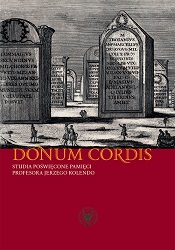
Cemetery from the Roman period in Opinogóra
Cmentarzysko z okresu wpływów rzymskich w Opinogórze
Keywords: Jerzy Kolendo; archaeology; Poland; Europe; University of Warsaw; Polish Academy of Sciences
Recently a quarter of a century has passed since the publication of Professor Jerzy Kolendo’s article in which,basing on the archival materials of the Warsaw Society of Friends of Science (hereinafter: WSFS), he determinedthe location of a necropolis of the Wielbark culture from Opinogóra (present-day Opinogóra Górna) in northMazovia and critically discussed the basis for its dating. Let us recall that in 1818 General Wincenty Krasiński,the owner of Opinogóra, donated to the collection of the WSFS a clay urn, which had supposedly been found inOpinogóra, and in 1822 some objects from the equipment of an inhumation grave, discovered in the general’spresence in the vicinity of the local church; he also mentioned another urn which had been destroyed at the time.In 1832, after the fall of the November Uprising, the collection of the WSFS were considered by the Russianauthorities to be war trophies and were transported to St Petersburg where they were divided – in accordancewith the tsar’s instructions – between various persons and institutions, while a part of the collection was simplydestroyed. Those specimens, however, are not the only “antiquities” which can be associated with the Opinogóracemetery of the Wielbark culture.At the Institute of Archaeology of the Jagiellonian University, in the collection of the former ArchaeologicalCabinet, a clay vessel is kept which found its way there together with the collection of Count AleksanderPrzezdziecki, which were willed by him to the Cabinet upon his death in 1871. The vessel is a deep bowl withan uneven surface, its colour ranging from brownish grey to brown, covered by irregular traces of horizontal,uneven smoothing. The height of the vessel is approximately 17–18 cm, the diameter of the rim is 25–25.5 cm, ofthe belly 27.5–28 cm, and of the base 11.5–12 cm (Fig. 1).The description of the vessel corresponds to type VIA in the Schindler/Wołągiewicz classifi cation of the potteryof the Wielbark culture. These vessels have a quite broad-ranging chronology: from phase B2/C1 to phase D,with most of the better dated specimens originating in phase B2/C1–C1a, even though younger vessels, from phasesC1b–C2, or even D, are just as common in the area of the right-bank Mazovia and Podlasie.Aleksander Przezdziecki displayed the vessel from Opinogóra at an exhibition of antiquities in Warsaw in1856. At the time the urn still contained “burnt bones, part of another urn burnt with bones and ashes, as wellas remains of red clay beads” and in this state it was preserved until the 1920s/1930s. Later, the contents wereremoved, probably during a secondary conservation, and were most likely lost. The urn from Opinogóra was probably given to Przezdziecki as a gift by Wincenty Krasiński. This could havebeen in early 1856 during the preparations for the above-mentioned antiquities exhibition. Aleksander Przezdzieckiwas one of its main organizers (among other tasks he was collecting exhibits), while General Wincenty Krasińskiwas the second largest exhibitor. Of course, it is not known how the urn was discovered. It can only be assumedthat it happened no earlier than in the summer of 1830 because otherwise the urn would have most likely beenincluded in the collection of the WSFS, like the fi nds from 1818 and 1822, and in 1832 it would have been confiscated by the Russians.Finally, in 1996 an iron strap-end fi tting, found by accident in the area of the church in Opinogóra, was published(Fig. 2). The specimen corresponds to type 4 of strap-end fi ttings of the Przeworsk culture in the Madyda--Legutko classifi cation. Fittings of this type are found in graves from phases B2b–C1a. The raw material may pointto its Przeworsk attribution and its date within the span of phases B2b–B2/C1. This, in turn, could suggest thatthe cemetery in Opinogóra belonged to a numerous group of necropoles of the Przeworsk culture in the area ofthe right-bank of Mazovia and Podlasie in phases B2/C1 which later have been adopted and used by the peopleof the Wielbark culture.The information about the discoveries made in the cemetery of Opinogóra suggests that the necropolis occupiedthe whole area of a small but distinctive hill (size: approximately 150×75 m) located on the brink of an upland,between two unnamed, regulated streams fl owing towards the Sona Prawa River (Fig. 3).
More...